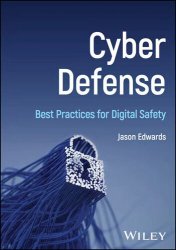 Название: Cyber Defense: Best Practices for Digital Safety Название: Cyber Defense: Best Practices for Digital Safety
Автор: Jason Edwards
Издательство: Wiley
Год: 2025
Страниц: 402
Язык: английский
Формат: pdf, epub (true)
Размер: 10.1 MB
Practical and theoretical guide to understanding cyber hygiene, equipping readers with the tools to implement and maintain digital security practices.
Cyber Defense is a comprehensive guide that provides an in-depth exploration of essential practices to secure one's digital life. The book begins with an introduction to cyber hygiene, emphasizing its importance and the foundational concepts necessary for maintaining digital security. It then dives into financial security, detailing methods for protecting financial accounts, monitoring transactions, and compartmentalizing accounts to minimize risks. Password management and multifactor authentication are covered, offering strategies for creating strong passwords, using password managers, and enabling multifactor authentication.
With a discussion on secure internet browsing practices, techniques to avoid phishing attacks, and safe web browsing, this book provides email security guidelines for recognizing scams and securing email accounts. Protecting personal devices is discussed, focusing on smartphones, tablets, laptops, IoT devices, and app store security issues. Home network security is explored, with advice on securing home networks, firewalls, and Wi-Fi settings. Each chapter includes recommendations for success, offering practical steps to mitigate risks.
Every device you connect to the internet—a smartphone, laptop, smart home device, or even a wearable fitness tracker—becomes a potential target for cybercriminals. The convenience of digital technology comes with the responsibility of safeguarding personal data and maintaining the integrity of the systems we rely on. From securing home networks to protecting sensitive communications and securing online transactions, understanding and applying cybersecurity best practices are essential for anyone who uses technology daily.
While many people believe that cyber threats are something that only large organizations or high-profile targets need to worry about, the reality is that anyone can become a victim. Cybercriminals continuously exploit vulnerabilities in both software and hardware, looking for ways to gain unauthorized access to personal information, financial assets, and private communications. As our individual lives and professional activities shift online, the risks associated with poor cybersecurity habits become more significant. This chapter aims to provide a comprehensive guide to securing your digital life, from understanding the importance of encryption to protecting your home network and safely navigating public Wi-Fi.
One of the most critical components of digital security is the network on which your devices operate. Securing your home network is the first line of defense, ensuring that unauthorized individuals cannot access your personal devices and sensitive information. By configuring your router securely, using strong passwords, and regularly updating firmware, you can significantly reduce your exposure to attacks. This section will delve into best practices for home network security, providing actionable steps to help you establish a secure and reliable online environment for yourself and your family.
Topics covered in Cyber Defense include:
• Data protection and privacy, providing insights into encrypting information and managing personal data
• Backup and recovery strategies, including using personal cloud storage services
• Social media safety, highlighting best practices, and the challenges of AI voice and video
• Actionable recommendations on protecting your finances from criminals
• Endpoint protection, ransomware, and malware protection strategies, alongside legal and ethical considerations, including when and how to report cyber incidents to law enforcement
Cyber Defense is an essential guide for anyone, including business owners and managers of small and medium-sized enterprises, IT staff and support teams, and students studying cybersecurity, information technology, or related fields.
Contents:
Introduction
Chapter 1: Why Cyber Safety Matters Today
Chapter 2: Understanding Cyber Safety in the Digital Age
Chapter 3: Understanding and Preventing Identity Theft
Chapter 4: Protecting Your Accounts with Strong Passwords and MFA
Chapter 5: Email Security Best Practices
Chapter 6: Managing Your Digital Footprint and Online Reputation
Chapter 7: Safe and Professional Use of Social Media
Chapter 8: Dealing with Cyberbullying and Online Harassment
Chapter 9: Children’s Online Safety and Parental Controls
Chapter 10: Avoiding Online Scams and Social Engineering Tricks
Chapter 11: Using AI Securely and Protecting Your Privacy
Chapter 12: Securing Your Devices and Wearables
Chapter 13: Managing Software and App Security on All Devices
Chapter 14: Defending Yourself Against Ransomware and Malware
Chapter 15: How to Stay Safe While Browsing the Internet
Chapter 16: Network Security
Chapter 17: Safeguarding Your Financial Assets and Secure Online Transactions
Chapter 18: Protecting Your dаta: Backups, Cloud Storage, and Disaster Recovery
Chapter 19: Cybercrimes and How to Report Them
Chapter 20: Preparing for Emerging Cyber Threats
Chapter 21: Teaching and Empowering Others in Cyber Safety
Appendix: Answers to Chapter Questions
Glossary
Index
Скачать Cyber Defense: Best Practices for Digital Safety
|